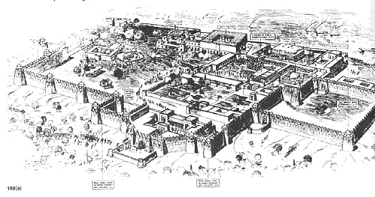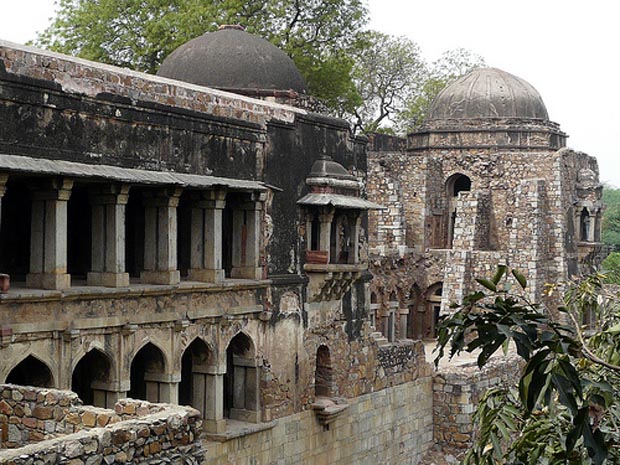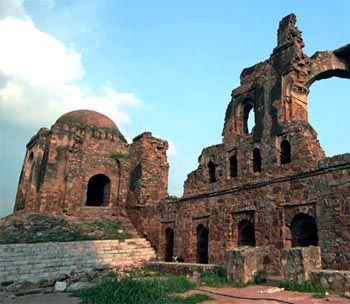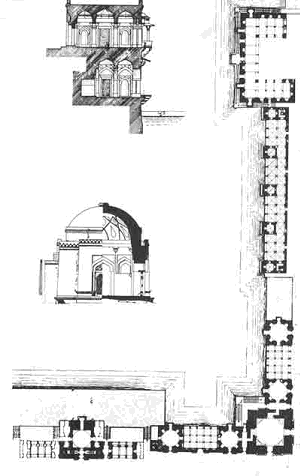Apr 18, 2025
Apr 18, 2025
 After the capricious reign of Muhammed bin Tughlaq, his cousin, the devout (and even bigoted!) Firoz Shah Tughlaq (1351-1388 A.D.) became Sultan. Firoz Shah inherited, thanks largely to the disastrous policies of his predecessor, nearly empty coffers and a disintegrating empire. This did not stop him from embarking on a vigorous campaign of building, and in the words of a contemporary historian he was eventually responsible for “1200 gardens around Delhi...200 towns, 40 mosques, 30 villages, 30 reservoirs, 50 dams, 100 hospitals, 100 public baths and 150 bridges.” These claims are no doubt exaggerated but underscore his interest in architecture. In his own words “...among the Gifts that God has bestowed on me...is a desire to erect public buildings.” *
After the capricious reign of Muhammed bin Tughlaq, his cousin, the devout (and even bigoted!) Firoz Shah Tughlaq (1351-1388 A.D.) became Sultan. Firoz Shah inherited, thanks largely to the disastrous policies of his predecessor, nearly empty coffers and a disintegrating empire. This did not stop him from embarking on a vigorous campaign of building, and in the words of a contemporary historian he was eventually responsible for “1200 gardens around Delhi...200 towns, 40 mosques, 30 villages, 30 reservoirs, 50 dams, 100 hospitals, 100 public baths and 150 bridges.” These claims are no doubt exaggerated but underscore his interest in architecture. In his own words “...among the Gifts that God has bestowed on me...is a desire to erect public buildings.” *
The architecture of Firoz Shah is stern, utilitarian, almost tragic - at times hauntingly lovely (Hauz Khas Madrasa by night), at times warningly forbidding. This is due in no small measure to its rough exposed finish (the glazed tiles having come off a long time ago) as well as the lack of skilled masons and sufficient capital. The unfortunate and appalling state of neglect of the monuments today does nothing to ameliorate this perception.

A new Capital
 Firoz Shah built a new capital city on the banks of the Yamuna, called Firoz Shah Kotla, thereby abandoning the old fort-city of Tughlaqabad. Apart from the desire of the new Sultan to make his mark, this decision could also have been prompted by an increasingly irregular water supply at Tughlaqabad.
Firoz Shah built a new capital city on the banks of the Yamuna, called Firoz Shah Kotla, thereby abandoning the old fort-city of Tughlaqabad. Apart from the desire of the new Sultan to make his mark, this decision could also have been prompted by an increasingly irregular water supply at Tughlaqabad.
The fort itself was fairly straightforward, using common-sense building principles used the world over for buildings of a similar type.
The king’s quarters as well as those of his wives and concubines were situated along the river-front. Within the perimeter walls of the fort were structures serving as barracks, armouries, rooms for servants, halls for audience, an imposing mosque, as well as public and private baths, a stepped well or baoli, and an Ashokan pillar removed from Ambala and mounted on top of a pyramidal three-tiered construction. Symbolically, this was an icon of the Sultan’s supremacy in North India, very much like the Gupta Iron Pillar in the Q’uwwat-ul-Islam mosque at the Qutb.
 Of Firoz Shah’s numerous mosques, the chief ones are the Kali masjid, the Begumpuri masjid, Kalan masjid and Khirki masjid at Jahanpanah. This last is interesting not only for its cruciform plan, but also because it is one of the few examples of covered mosques in India. The congregational nature of worship in Islam has generally resulted in mosques having a large common open space in which to pray. But the roofing of the Khirki masjid and dividing of the interior spaces into various small courtyards - perhaps to avoid the scorching heat of North India in the summer - effectively broke up the congregation into small groups. Whatever the reason for this unusual masjid, it was apparently not very successful as a building type and was not repeated.
Of Firoz Shah’s numerous mosques, the chief ones are the Kali masjid, the Begumpuri masjid, Kalan masjid and Khirki masjid at Jahanpanah. This last is interesting not only for its cruciform plan, but also because it is one of the few examples of covered mosques in India. The congregational nature of worship in Islam has generally resulted in mosques having a large common open space in which to pray. But the roofing of the Khirki masjid and dividing of the interior spaces into various small courtyards - perhaps to avoid the scorching heat of North India in the summer - effectively broke up the congregation into small groups. Whatever the reason for this unusual masjid, it was apparently not very successful as a building type and was not repeated.
Today the Khirki masjid has its own village - Khirki village - in Delhi, near modern Saket. Indeed, from the road, the mosque can barely be glimpsed. The narrow paths of the village twist and turn until suddenly you are face to face with an imposing structure mounted on an impressively high plinth. The village chokes the mosque, encroaches on its space - but perhaps the very unexpectedness of the building is the reason for its powerful solemnity. A failure as a building type, the Khirki Masjid today is an architectural gem tucked away in a forgotten corner of one of India’s largest metropolises.
The Madrassa at Hauz Khas
 To be forgotten - is not the fate of the Madrassa - or religious school - at Hauz Khas - having for company some of the most exclusive (and expensive) restaurants and boutiques in the city. The story of modern Hauz Khas village is all too familiar - of an urban village being hijacked for its (initially) low property prices. Today Hauz Khas sells you India - if you’re a foreigner - neatly packaged, right from ‘antiques’ from Kerala and Tamil Nadu to fabrics to paintings, and when you’re tired of it all, there are the restaurants to relax. And spend some more money.
To be forgotten - is not the fate of the Madrassa - or religious school - at Hauz Khas - having for company some of the most exclusive (and expensive) restaurants and boutiques in the city. The story of modern Hauz Khas village is all too familiar - of an urban village being hijacked for its (initially) low property prices. Today Hauz Khas sells you India - if you’re a foreigner - neatly packaged, right from ‘antiques’ from Kerala and Tamil Nadu to fabrics to paintings, and when you’re tired of it all, there are the restaurants to relax. And spend some more money.
All this activity, of course, does not detract from the solemnity of the monument. Originally the site of a large water-storage tank built by Ala-ud-Din Khilji, a large school, mosque and his own tomb were added by Firoz Shah. These buildings are laid out in an ‘L’ shape on a high rocky outcrop overlooking the tank. Firoz Shah’s tomb is at the junction of this ‘L’, and is also the highest building there, surmounted by a dome with its interior finely stuccoed.
Exterior surface decorations have long disappeared, of course, so what we are left with is a network of buildings, almost barrack-like in their disposition, with a mosque at one end, and teaching cells at the other, the whole composition hinging on Firoz Shah’s tomb as the pivot. Jaali windows overlooking the tank (and the setting sun) make for a fine place to spend summer evenings, and the whole complex nestles in the midst of a forest - the Deer Park at Hauz Khas.
The major buildings of Firoz Shah’s reign would end here - except for one example. This is the tomb of Khan-i-Jahan Telengani, an official at the court. His tomb, though otherwise decaying, marks a radical design innovation in the sense that for the first time the plan was octagonal instead of square. This may have been done to facilitate the placing of the dome at the summit, which would be far easier over an octagon than over a square. Whatever the reason, this tomb would be the forerunner and model for tombs of the next two dynasties, each of whom would refine it further, and persist even after the Mughal invasion of India.
The Death of Delhi
In the last years of the 14th century, Delhi was invaded by the hordes of Timurlane, the grandson of the terrible Mongol scourge, Chengiz Khan. The decaying empire of the Tughlaqs could offer no more than feeble resistance, and thousands of citizens were slaughtered. Timur left behind him a shattered and emasculated city, which would not rise to its former glory for many decades hence.
10-Mar-2002
More by : Ashish Nangia

|
really informative , just the breif and complete answer to every basic or complexly basic query related to fst |